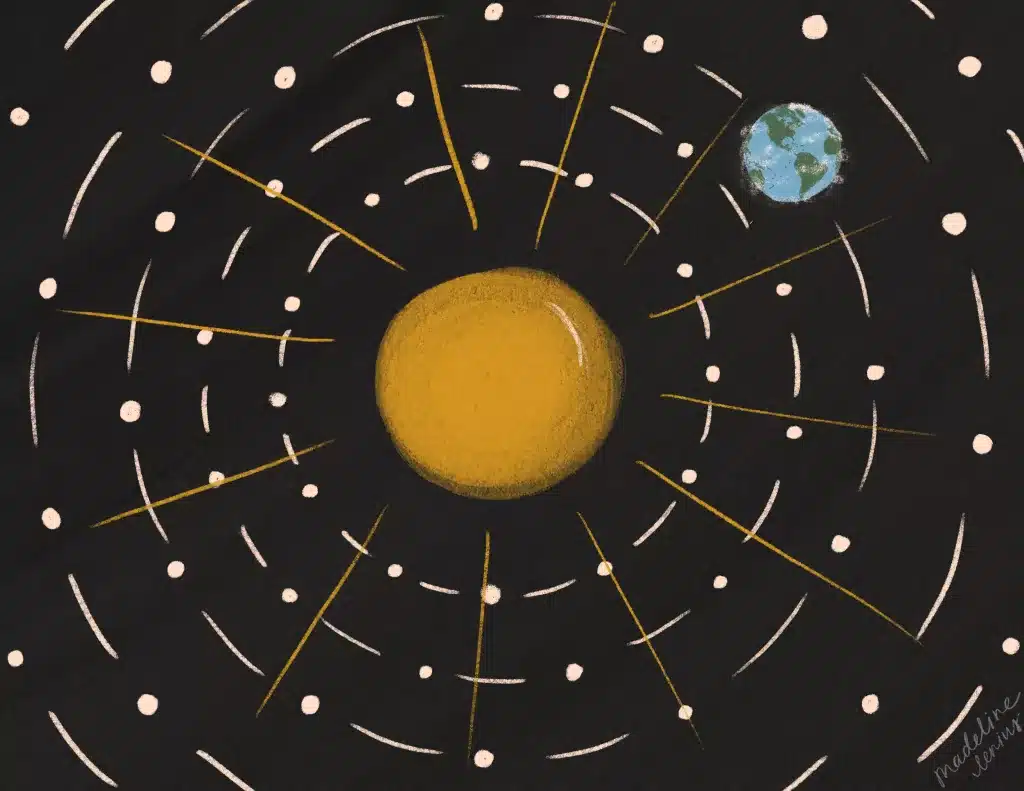
Minnesota Congregations Go Solar
Story and art by MNIPL Intern Maddie Lenius
In 2019, Tim Abrahamson and Stewart Herman began advocating for their Minneapolis church, University Lutheran Church of Hope, to consider installing solar panels. After collaborating with other members, MNIPL, and outside contractors, in June 2020 the congregation approved a design to source 100% of the building’s electricity from solar energy. The panels were installed and have been producing power since early 2022. In addition to participating in the church’s Green Team, Tim and Stewart have both completed net zero projects at their homes. They describe their passion for caring for the environment as grounded in their faith identity.
“We’re at the end of our lives, we’re in our 70s, so what do we have left? Another 10, 20 years? But we look at our children or our grandchildren and we say we’ve gotta do it for them,” Tim said. “There’s this idea of who we are, sort of us as human beings on the planet, Christians within the context of Lutheranism, but also whose we are: we are children of God. We can’t disengage ourselves from that reality. And it’s very easy to do that.”
The Unitarian Universalist Congregation of Duluth, located 150 miles north of ULCH, celebrated the dedication of their solar array on the summer solstice in 2023. Beth Tamminen, a member of the Climate Action Team, explained that this day was long anticipated for the congregation. UUCD has been planning a transition to solar energy since the completion of their new building in 2008. After years of perseverance through financial and technical set-backs, they became the first congregational building in the Twin Ports region to install solar.
“Unitarian Universalism has 7 principles that we agree upon as a covenantal faith rather than a creedal faith and the seventh principle is respect for the interdependent web of all existence of which we are a part,” Beth said. “There are a lot of things that interest and concern me, but… if we can make it so difficult for humans to continue to live on this earth by what we are doing to the atmosphere and the land and the biodiversity and everything, then any other work for justice is just going to be worse. It’s such a multiplying factor for solving any of the other human problems that we have.”
A Commitment to Hope
Grounded in their belief that humanity is interconnected with the rest of the natural world, both of these congregations are committed to taking action. They have learned how to find hope through this process.
“We can just get totally mired in angst sometimes… because we’re all so stressed, what is going to happen? It’s despair,” Pastor Jen Nagel of University Lutheran Church of Hope said. “In some ways this [work] is a healthy response to our despair and doing it out of that groundedness in identity. That identity is whose we are, we are God’s children, we’ve got the capacity to at least be part of the change, so do it. That’s our response to despair. I think that gives a lot of people a lot of hope. I like watching people figure out what is authentic hope.”
At ULCH and UUCD, a significant part of the process of taking action is collaboration and relying on the diverse skills within the congregation.
“One thing I was extremely grateful for is, we have in our congregation, a man who’s very interested in climate who’s an electrical engineer and actually worked for the power company and had worked on some solar installations and had done some purchasing for them,” Beth said. “He was able to look at the proposals and talk with them about why they were doing this and not doing that. It makes you feel better when you have somebody who knows how to ask the questions and keep things moving. So when I talk to others about this I tell them to look for someone in your congregation who has some experience in this field.”
Additionally, having congregation members involved in the process creates an opportunity for people to learn from each other.
The Benefits of Solar
Solar arrays convert energy from the sun into electricity which can be used directly in a building. If the array is producing more electricity than the building is using at that moment, it flows onto an electrical company’s grid. If the building uses more electricity than the array is producing, they pull from this grid. If a building is aiming to produce 100% of their electrical use, the goal is for these two measurements to even out. Otherwise, the utility company pays for any excess produced or charges the customer for additional electricity used.
Having congregation members involved in solar installation, or other community projects, creates an opportunity for people to learn from each other. Because Stewart and Tim had prior experience with solar, they were able to help other members understand how it works. Throughout this process, they continued to develop their skills and learn new things.
“We’re doing things where people can actually learn and develop skills so they can feel better about their own capacities to do things,” Stewart said. “I think it’s empowering in that kind of way. In a world where craftsmanship is kind of getting shoved to the side, and a lot of people have jobs where they can’t really do something with their hands and this is something where you, it’s very old fashioned, we’re doing things with our hands. It takes effort, it takes sweat, and for me it takes getting to know the city better… learning about different types of supplies. It’s a kind of very well-rounded type of experience.”
Not only was the opportunity to learn and practice physical skills a meaningful personal experience, it also created a stronger sense of community between people working together.
“Shared experience is really essential and it brings that cohesiveness to these different groups that are working to do what they can to save the planet or for social justice. It takes that kind of effort and we have great models here in this congregation,” Tim said.
An Opportunity to Reflect
Those involved in social justice movements are familiar with the idea that ignorance upholds injustice while education is the first step in acting for justice. People with privilege cannot engage in dismantling and reconstructing oppressive systems until they understand how these systems function and their personal role within them. This idea is most often applied within the context of social and political systems. However, environmental justice similarly requires an understanding of physical and mechanical systems, such as how we create and use physical resources. Pastor Jen explained the parallels between having access to racial privilege and electricity.
“For so long I’ve lived in the privilege of ‘just’ being white. I didn’t have to think about my people, what we’ve done, and how colonization worked with it,” she said. “At our best, we’ve gotten to the particularities of what this all means. I think you can link that to the privilege of just using electricity. We just use electricity because it’s always there, but we do better when we can get to the granular of the peak times and figuring out the flow and understanding our use and our world’s use.”
The Cycle of the Sun
The amount of energy produced by an individual solar array differs depending on the season and time of day. Similarly, the amount of electricity that people use during different times fluctuates. These patterns typically have some overlap. For example, production is higher during the day and over the summer when there is more sunlight. Electrical use also tends to increase during these times when more air conditioners are running. However, production and use don’t always align. For example, more lights need to be turned on when it is dark outside. Being connected to a power grid currently allows solar-powered buildings to even out their use and production. But as our economy moves away from large utility companies towards more smaller producers, we will have to consider how to best manage our usage and store energy, such as using batteries, for low production times. Sunlight is not an infinite resource, but understanding its cycles allows us to live in greater alignment with them.
“I’ve noticed that electricity is something that you pay the bill for, and that’s about as much as you want to know,” Stewart said. “I didn’t even know about where electricity came from until I was in my mid-20s… People have very busy lives; we’re so used to electricity that we don’t think it’s a struggle to get electricity…I hope a growing margin of people will be interested in thinking about the cycles of the sun and how that affects their lives, as part of their own spirituality. To realize that we were designed by God to live in the cycle of daily life. You can see why I’m fascinated with the sun and wish that others would get an appreciation for that flow in their lives and not just take it for granted.”
The recognition of our connection to the patterns of the natural world is also a value at UUCD, which inspired them to host the dedication of their new solar array on the summer solstice. As residents of Northern Minnesota, their community also has a particular connection to natural cycles because of the intensity of seasonal changes.
“There’s a particular hymn or chant for change of seasons we do around the solstices and equinoxes as part of our services… It’s just a part of the awareness of our planet and its relationship to the sun,” Beth said. “I think you get an even more distinct sense of seasons the farther North you are, or perhaps the farther South you are too, because the day length changes so much… The drama of the change makes the whole solstice/equinox thing more specific.”
Making Solar Accessible
Solar energy isn’t an accessible or efficient option for every household and building. But these projects at University Lutheran Church of Hope and Unitarian Universalist Congregation of Duluth demonstrate the power of collaboratively developing and utilizing the skills within our communities, understanding how we obtain and use natural resources, and taking action to live in more authentic alignment with the world around us.
“We have to realize that people having more autonomy and getting together in smaller communities and cooperatives actually provides much healthier lives,” Beth said. “There’s a lot of movement, I think, around the globe for people to start to reclaim their communities and their ability to work together, but there’s also a lot of challenges in that. The power that’s become institutionalized particularly in the last 150 years because of the fossil fuel economy, but also the last few hundred years of corporate that needs to somehow be turned around… to keep people more connected to the Earth and understanding our dependence and our part of Earth as home, not a natural resource we can extract.”
Do you have a story to share?
Your community's climate actions are inspiring! Share your story with others ...
